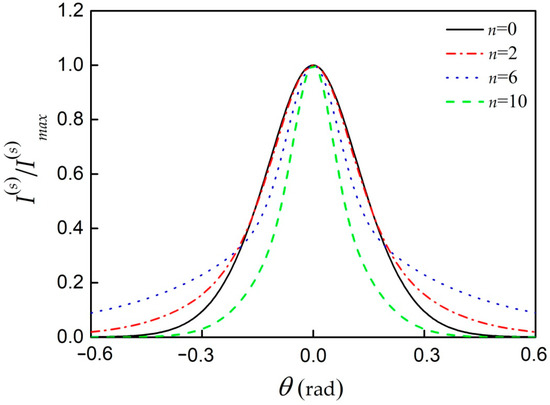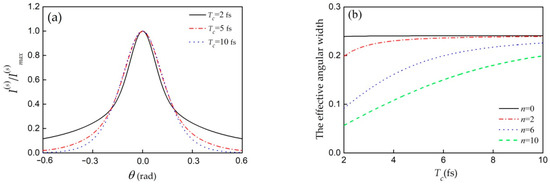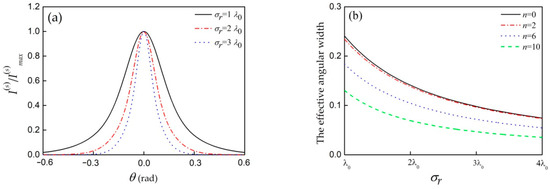Abstract
According to first-order Born approximation, the scattering of a partially coherent pulse with cosine-Gaussian correlation by a medium was studied. On the basis of analytic expression, the changes in intensity evolution of the scattered pulse are discussed. The influences of pulse and medium characteristics on the intensity of the scattered pulse were investigated. The intensities of a Gaussian Schell-model (GSM) pulse and a cosine-Gaussian-correlated Schell-model (CGSM) pulse, both scattered by the same medium, are compared, and their similarities and differences are examined in detail. The effective angular width of the scattered pulse could be modulated by the parameters of the pulse and medium. The obtained results could find potential applications in pulsed beam scattering.
1. Introduction
Light scattering has received continuous attention from researchers because of its potential applications in some areas, like medical detection and ocean remote sensing. Since pioneering research in 1870, many studies have been carried out in this field, where the optical statistical characteristics of a scattered pulse, such as intensity, polarization, and coherence, were extensively studied [1,2,3,4]. The inverse problem, obtaining information on a scatterer through the characteristics of a scattered pulse, was also examined [5,6]. However, most of the above investigations were carried out on the scattering of statistically stationary fields.
The optical pulse is an important part of a broad class of light beams [7]. The basic concepts and representations of partially coherent pulses were established [8,9]. In the discussion of pulsed-beam scattering [10,11,12,13,14,15,16], the initial pulse was fully or partially coherent, and the complex degree of coherence of the majority of these partially coherent pulses is a conventional Gaussian Schell-mode function [17]. In recent years, a large number of partially coherent sources with other types of Schell-mode coherence were proposed, e.g., nonuniform-correlation [18], multi-Gaussian Schell-model [19,20], Laguerre-Gaussian and Hermite-Gaussian Schell-model [21], and sinc-correlation sources [22]. Some experiments related to the realization of these pulses have also been made [23,24].
We studied the scattering of a cosine-Gaussian-correlated Schell-model (CGSM) pulse on a quasihomogeneous medium, and investigated the intensity evolution of the scattered pulse within the accuracy of first-order Born approximation. We pay more attention to examining the intensity variation of the scattered pulse with order-parameter n, duration, the temporal-coherence length of the initial pulse, and the radius and correlation length of the medium.
2. Theory
The temporal mutual coherence function for a CGSM pulse has the following form [19]:
where E(t1) and E(t2) are the complex analytic signals of pulse realizations at time t1 and t2, respectively; the asterisk is the complex conjugate; Γ0 is a positive constant; T0 represents the pulse duration; Tc is the temporal-coherence length denoting the temporal correlation of the pulse; ω0 describes the carrier frequency of the pulse [25]; n is a constant greater than zero and does not need to be an integer. Obviously, for the case of n = 0, a CGSM pulse is simplified to a GSM pulse.
By performing Fourier transform on Equation (1), the cross-spectral density function for a CGSM pulse is given by [11]
where
where Ω0 denotes the spectral width of the CGSM pulse. Ωc represents the spectral coherence width of the pulse. cosh(x) is a hyperbolic cosine function.
Suppose a CGSM pulsed beam is incident on a scatterer along the direction described by unit vector s0 (Figure 1). The cross-spectral density of a CGSM pulse at two points with position vectors r1′ and r2′ can be written as [26]

Figure 1.
Notation relating to scattering a cosine-Gaussian-correlated Schell-model (CGSM) pulse by a medium.
In the scattering process, the correlation function of the scattering potential is used to describe the scattering properties of a random medium [27]. In [10], it was assumed that the resonance frequency of molecules or atoms in the medium is approximately represented by the carrier frequency of the pulse. Therefore, the correlation function of the scattering potential is expressed as [28,29]
where F(r′, ω) is defined as the scattering potential of the medium, and<·>denotes averaging over the ensemble of a random medium [30].
According to the first-order Born approximation, we obtained the formula for the cross-spectral density function of the scattered pulse [31,32]:
where rs1 and rs2 are the position vectors of two observation points (s1 and s2 are unit vectors). K1 = −k1(s1 − s0) and K2 = k2(s2 − s0) are the momentum-transfer vectors. D is the domain that the medium occupies.
A quasihomogeneous medium was considered in this paper of which the correlation function of the scattering potential is given by [1,29,33]
where C0 is a positive constant, σR is the effective radius of the medium, and σr is the correlation length of the media, which must satisfy inequality σR ≥ σr.
When we substitute from Equation (10) into Equation (9), we can obtain the cross-spectral density of a pulse scattered by a medium [34]:
By using theinverse Fourier transform of Equation (11), the mutual-coherence function of the scattered pulse is expressed by the following formula:
where
With the help of unified theory [35,36], where spectral density, spectral degree of coherence, and spectral degree of polarization can be treated in the same manner, the intensity of the scattered pulse has the following form.
3. Intensity Properties of CGSM Pulse Scattered by a Medium
On the basis of Equation (15), the intensity involution of a CGSM pulse scattered by a random medium can be studied as follows. Figure 2 shows changes in the normalized intensity of the scattered pulse with the scattering angle for four different values of parameter n. In the following numerical calculations, unless specified otherwise, parameters were chosen as: T0 = Tc = 5 fs, λ0= 800 nm, σR = 10 λ0, σr = λ0, and t = r/c. Figure 2 shows that the intensity properties of the scattered CGSM pulse were closely related to parameter n. For a GSM pulse, the intensity distribution of the scattered pulse has Gaussian distribution. With an increase of parameter n, the effective angular width of the scattered pulse decreases. Here, the effective angular width of the scattered pulse is defined as the 1/e point of the normalized intensity of the scattered pulse [37].

Figure 2.
Normalized intensity of scattered pulse as function of scattering angle θ for four different values of parameter n.
Figure 3a illustrates the variations of the normalized intensity of the scattered pulse with scattering angle θ, n = 2. In order to display the impact of initial pulse duration T0 on the intensity of the scattered pulse, Figure 3b gives the changes of the effective angular width of the scattered pulse with initial pulse duration T0. It is clear from Figure 3a that the effective angular width of the scattered pulse increased when the initial pulse duration T0 increased. Furthermore, Figure 3b shows that, for small values of parameter n, the effective angular width of the scattered pulse varied rapidly with initial pulse duration T0; however, it changed slowly for large values of parameter n.

Figure 3.
(a) Normalized intensity of scattered pulse against scattering angle θ for different initial pulse duration T0. (b) Effective angular width of scattered pulse against initial pulse duration T0.
Figure 4 shows (a) the behavior of the normalized intensity of the scattered pulse as a function of scattering angle θ, and (b) the effective angular width of the scattered pulse against temporal-coherence length Tc of the initial pulse. The effective angular width of the scattered pulse increased with increasing temporal-coherence length Tc of the initial pulse. However, the effective angular width of the scattered pulse changed rapidly with temporal-coherence length Tc for large values of parameter n. Especially with an increase of temporal-coherence length Tc of the initial pulse, the effective angular width of the scattered pulse remained nearly unchanged for the case of n = 0, and it converged to a constant 0.241 for the case of n = 0, 2, 6, 10. The reason for this phenomenon is as follows.

Figure 4.
(a) Normalized intensity of scattered pulse against scattering angle θ; (b) effective angular width of scattered pulse against temporal-coherence length Tc of initial pulse.
When temporal-coherence length Tc of the initial pulse is infinite, the intensity of the scattered pulse takes the following form:
which is independent of temporal-coherence length Tc of the initial pulse and parameter n. Therefore, the effective angular width of the scattered pulse converged to a constant when temporal-coherence length Tc of the initial pulse increased for different n parameters.
Figure 5 illustrates the influence of effective radius σR of the medium on the normalized intensity of the scattered pulse. As shown in Figure 5, the effective angular width of the scattered pulse increased as effective radius σR of the medium decreased. For large values of parameter n, effective radius σR of the medium had little impact on the effective angular width of the scattered pulse.

Figure 5.
(a) Normalized intensity of scattered pulse against scattering angle θ for three different values of effective radius σR of medium. (b) Effective angular width of scattered pulse against effective radius σR of medium.
Figure 6 displays the effect of correlation length σr of the medium on the normalized intensity of the scattered pulse. The effective angular width of the scattered pulse decreased with increasing correlation length σr of the medium. In comparison with effective radius σR, the correlation length σr of the medium resulted in a more rapid change in the effective angular width of the scattered pulse.

Figure 6.
(a) Normalized intensity of scattered pulse against scattering angle θ for three different values of correlation length σr of medium. (b) Effective angular width of scattered pulse against correlation length σr of medium.
4. Conclusions
In summary, we investigated the intensity evolution of a CGSM pulse scattered by a quasihomogeneous medium on the basis of the scattering theory of nonstationary fields. We derived the closed-form formula for the intensity of the scattered pulse in the time domain. We found that the effective angular width of the scattered pulse can be modulated by the pulse and medium parameters. It increased when the pulse parameters increased or the medium parameters decreased. When variations in the correlation length of the medium and the effective radius of the medium were the same, the former resulted in a more rapid change in the effective angular width of the scattered pulse. In addition, the intensity properties of the scattered CGSM pulse were closely related to the n parameter. Variations of the effective angular width of the scattered pulse induced by parameter n were analyzed in detail. For large values of parameter n, the effective angular width of the scattered pulse changed slowly with the initial pulse duration, and sharply with the temporal-coherence length of the pulse. These results might find uses in practical applications of pulsed-beam scattering.
Author Contributions
Data curation, writing—original draft, and methodology, H.W.; writing—review and editing, X.Y. and X.F.; formal analysis, Z.Z.; project administration, Z.Z. and L.P.; funding acquisition, L.P. All authors have read and agreed to the published version of the manuscript.
Funding
This research was funded by the National Natural Science Foundation of China (grant number 61675094) and the Foundation of Henan Educational Committee (2016GGJS-116).
Conflicts of Interest
The authors declare no conflict of interest.
References
- Wolf, E.; Foley, J.T. Scattering of electromagnetic fields of any state of coherence from space-time fluctuations. Phys. Rev. A 1989, 40, 579–587. [Google Scholar] [CrossRef]
- Wu, H.; Pan, X.N.; Zhu, Z.H.; Ji, X.L.; Wang, T. Reciprocity relations of an electromagnetic light wave on scattering from a quasi-homogeneous anisotropic media. Opt. Express 2017, 25, 11297–11305. [Google Scholar] [CrossRef]
- Wang, F.; Chen, Y.H.; Liu, X.L.; Cai, Y.J.; Ponomarenko, S.A. Self-reconstruction of partially coherent light beams scattered by opaque obstacles. Opt. Express 2016, 24, 23735–23746. [Google Scholar] [CrossRef]
- Jung, J.H.; Kim, J.; Seo, M.K.; Park, Y.K. Measurements of polarization-dependent angle-resolved light scattering from individual microscopic samples using Fourier transform light scattering. Opt. Express 2018, 26, 7701–7710. [Google Scholar] [CrossRef]
- Zhao, D.M.; Korotkova, O.; Wolf, E. Application of correlation-induced spectral changes to inverse scattering. Opt. Lett. 2007, 32, 3483–3485. [Google Scholar] [CrossRef]
- Lahiri, M.; Wolf, E.; Fischer, D.G.; Shirai, T. Determination of correlation functions of scattering potentials of stochastic media from scattering experiments. Phys. Rev. Lett. 2009, 102, 123901. [Google Scholar] [CrossRef]
- Agrawal, G.P. Nonlinear Fiber Optics, 4th ed.; Academic: New York, NY, USA, 2007. [Google Scholar]
- Pääkkönen, P.; Turunen, J.; Vahimaa, P.; Friberg, A.T.; Wyrowski, F. Partially coherent Gaussian pulses. Opt. Commun. 2002, 204, 53–58. [Google Scholar]
- Lajunen, H.; Vahimaa, P.; Tervo, J. Theory of spatially and spectrally partially coherent pulses. J. Opt. Soc. Am. A 2005, 22, 1536–1545. [Google Scholar] [CrossRef]
- Ding, C.L.; Cai, Y.J.; Korotkova, O.; Zhang, Y.T.; Pan, L.Z. Scattering-induced changes in the temporal coherence length and the initial pulse duration of a partially coherent plane-wave pulse. Opt. Lett. 2011, 36, 517–519. [Google Scholar] [CrossRef]
- Wang, H.X.; Ding, C.L.; Ma, B.H.; Zhao, C.H.; Pan, L.Z. The intensity properties of a multi-Gaussian Schell-model pulse scattering from a sphere with semisoft boundaries. Opt. Quant. Electron 2016, 48, 1–12. [Google Scholar] [CrossRef]
- Wang, H.X.; Ding, C.L.; Ma, B.H.; Zhao, C.H.; Pan, L.Z. Statistical properties of a stochastic electromagnetic pulse scattering by a quasi-homogeneous random medium. Opt. Quant. Electron 2015, 47, 3365–3380. [Google Scholar] [CrossRef]
- Ding, C.L.; Cai, Y.J.; Zhang, Y.T.; Pan, L.Z. Scattering of a partially coherent plane-wave pulse on a deterministic sphere. Phys. Lett. A 2012, 376, 2697–2702. [Google Scholar] [CrossRef]
- Devaux, F.; Lantz, E. 3D-PSTD simulation and polarization analysis of a light pulse transmitted through a scattering media. Opt. Express 2013, 21, 24969–24984. [Google Scholar] [CrossRef]
- Mounaix, M.; Defienne, H.; Gigan, S. Deterministic light focusing in space and time through multiple scattering media with a time-resolved transmission matrix approach. Phys. Rev. A 2016, 94, 041802. [Google Scholar] [CrossRef]
- Eggert, J.; Bourdon, B.; Nolte, S.; Rischmueller, J.; Imlau, M. Chirp control of femtosecond-pulse scattering from drag-reducing surface-relief gratings. Photon. Res. 2018, 6, 542–548. [Google Scholar] [CrossRef]
- Wang, F.; Cai, Y.J.; Lin, Q. Experimental observation of truncated fractional Fourier transform for a partially coherent Gaussian Schell-model beam. J. Opt. Soc. Am. A 2008, 25, 2001–2010. [Google Scholar] [CrossRef]
- Lajunen, H.; Saastamoinen, T. Non-uniformly correlated partially coherent pulses. Opt. Express 2013, 21, 190–195. [Google Scholar] [CrossRef]
- Ding, C.L.; Korotkova, O.; Zhang, Y.T.; Pan, L.Z. Cosine-Gaussian correlated Schell-model pulsed beams. Opt. Express 2014, 22, 931–942. [Google Scholar] [CrossRef]
- Yao, M.; Korotkova, O.; Ding, C.L.; Pan, L.Z. Position modulation with random pulses. Opt. Express 2014, 22, 16197–16206. [Google Scholar] [CrossRef]
- Ding, C.L.; Koivurova, M.; Turunen, J.; Pan, L.Z. Temporal self-splitting of optical pulses. Phys. Rev. A 2018, 97, 053838. [Google Scholar] [CrossRef]
- Zhao, Z.G.; Ding, C.L.; Zhang, Y.T.; Pan, L.Z. Spatial-Temporal Self-Focusing of Partially Coherent Pulsed Beams in Dispersive Medium. Appl. Sci. 2019, 9, 3616. [Google Scholar] [CrossRef]
- Torres-Company, V.; Mínguez-Vega, G.; Lancis, J.; Friberg, A.T. Controllable generation of partially coherent light pulses with direct space-to-time pulse shaper. Opt. Lett. 2007, 32, 1608–1610. [Google Scholar] [CrossRef] [PubMed]
- Turunen, J. Low-coherence laser beams. In Laser Beam Propagation: Generation and Propagation of Customized Light; Forbes, A., Ed.; CRC Press: Boca Raton, FL, USA, 2014. [Google Scholar]
- Ding, C.L.; Pan, L.Z.; Lü, B.D. Phase singularities and spectral changes of spectrally partially coherent higher-order Bessel-Gauss pulsed beams. J. Opt. Soc. Am. A 2009, 26, 2654–2661. [Google Scholar] [CrossRef] [PubMed]
- Wang, T.; Zhao, D.M. Scattering of scalar light wave from a Gaussian–Schell model medium. Chin. Phys. B 2010, 19, 084201. [Google Scholar]
- Ding, C.L.; Cai, Y.J.; Zhang, Y.T.; Pan, L.Z. Scattering-induced changes in the degree of polarization of a stochastic electromagnetic plane-wave pulse. J. Opt. Soc. Am. A 2012, 29, 1078–1090. [Google Scholar] [CrossRef] [PubMed]
- Wolf, E. Principles of Optics; Cambridge University Press: Cambridge, UK, 2007. [Google Scholar]
- Foley, J.T.; Wolf, E. Frequency shifts of spectral lines generated by scattering from space-time fluctuations. Phys. Rev. A 1989, 40, 588–598. [Google Scholar] [CrossRef] [PubMed]
- Wang, H.; Li, X.Y. Propagation of partially coherent controllable dark hollow beams with various symmetries in turbulent atmosphere. Opt. Laser Eng. 2010, 48, 48–57. [Google Scholar] [CrossRef]
- Zhang, Y.Y.; Zhao, D.M. The coherence and polarization properties of electromagnetic rectangular Gaussian Schell-model sources scattered by a deterministic medium. J. Opt. 2014, 16, 125709. [Google Scholar] [CrossRef]
- Wolf, E. Introduction to the Theory of Coherence and Polarization of Light, 1st ed.; Cambridge University Press: Cambridge, UK, 2007. [Google Scholar]
- Zhang, Y.Y.; Zhao, D.M. Scattering of Hermite–Gaussian beams on Gaussian Schell-model random media. Opt. Commun. 2013, 300, 38–44. [Google Scholar] [CrossRef]
- Mao, H.D.; Chen, Y.H.; Liang, C.H.; Chen, L.F.; Cai, Y.J.; Ponomarenko, S.A. Self-steering partially coherent vector beams. Opt. Express 2019, 27, 14353–14368. [Google Scholar] [CrossRef]
- Wolf, E. Unified theory of coherence and polarization of random electromagnetic beams. Phys. Lett. A 2003, 312, 263–267. [Google Scholar] [CrossRef]
- Zhu, Y.B.; Zhao, D.M. Propagation of a random electromagnetic beam through a misaligned optical system in turbulent atmosphere. J. Opt. Soc. Am. A 2008, 25, 2408–2414. [Google Scholar] [CrossRef]
- Visser, T.D. Optical Coherence; Wiley Online Library: Hoboken, NJ, USA, 2016. [Google Scholar]
© 2020 by the authors. Licensee MDPI, Basel, Switzerland. This article is an open access article distributed under the terms and conditions of the Creative Commons Attribution (CC BY) license (http://creativecommons.org/licenses/by/4.0/).